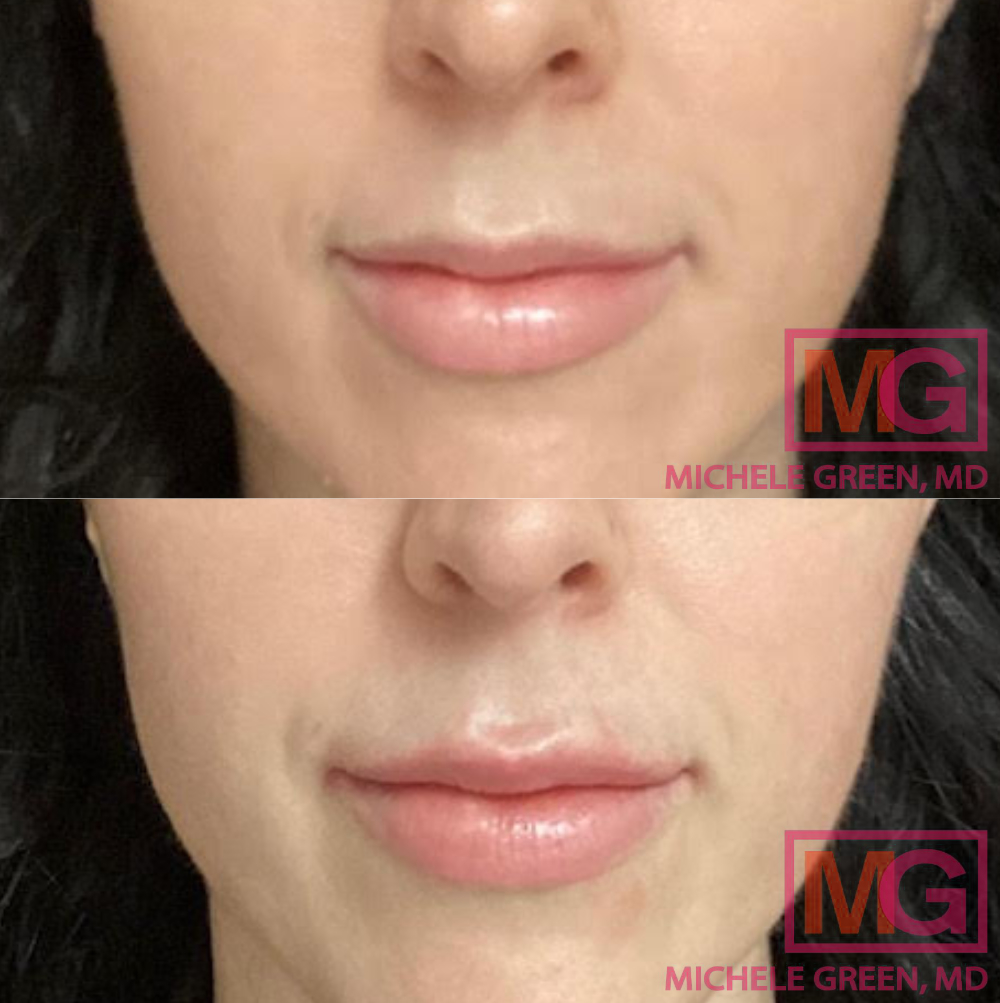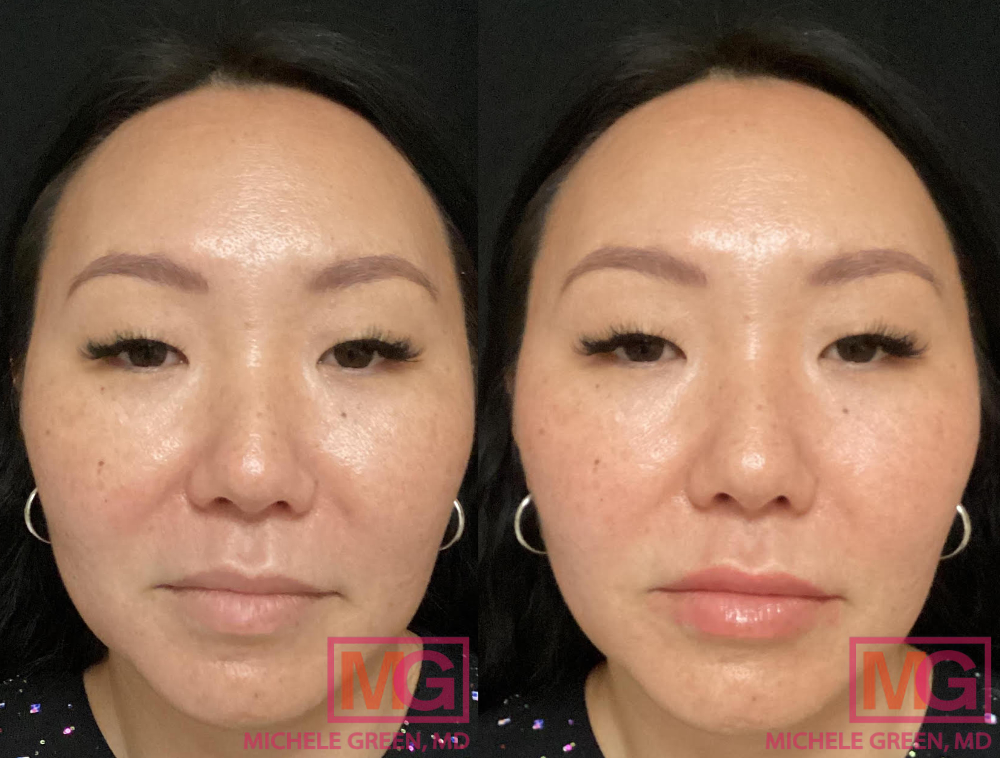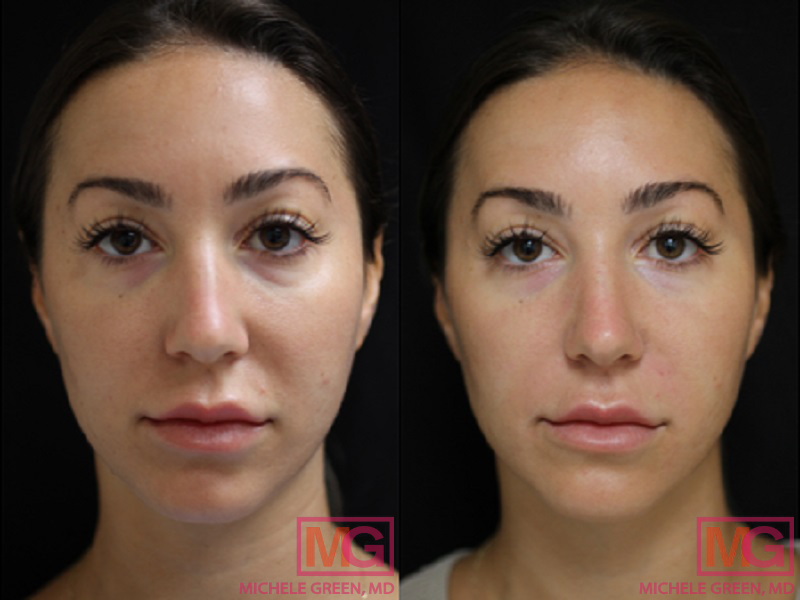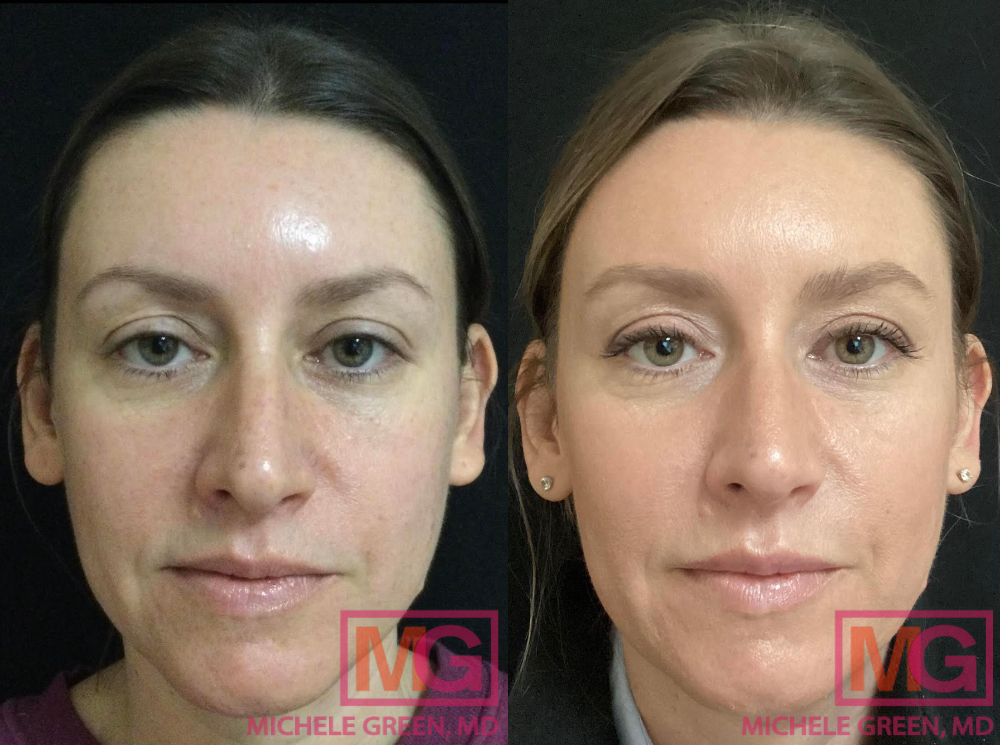Lip Filler Migration
Lip augmentation with dermal fillers is a popular choice for achieving a fuller pout, more symmetrical lips, and reducing fine lines around the mouth. Celebrities and influencers on social media platforms like TikTok have been sharing their experiences with dermal filler treatments to get plump, full lips, which has increased awareness of this cosmetic option. These discussions have raised numerous questions about lip fillers, also known as lip injections, and potential side effects, including lip filler migration. If you’re wondering whether dermal filler treatment is right for you, the best first step is to schedule a consultation with world-renowned, board-certified dermatologist Dr. Michele Green in NYC.
Lip filler migration happens when the filler moves away from the injection site, which, in the case of lip fillers, means it moves outside the lip border. While lip filler migration is usually not dangerous, it can cause an asymmetrical look to the lips, along with bulges and bumps outside the lip lines. Dermal fillers will naturally dissolve over time, typically taking 6 to 18 months to dissolve completely. Fortunately, there are treatment options for those experiencing hyaluronic acid-based filler migration, such as injecting the enzyme hyaluronidase, which dissolves the filler quickly. Still, the best way to prevent lip filler migration is to have the procedure performed by an expert injector, like New York City-based dermatologist Dr. Michele Green.
With over 25 years of experience, Dr. Michele Green, a renowned board-certified dermatologist, has been delivering expert care to her patients at her Upper East Side dermatology practice in New York City. Her approach to dermal fillers, which prioritizes natural-looking results, has made her a trusted name in the field. At Dr. Green’s office, she offers many types of dermal fillers tailored to meet each patient’s individual needs, including Juvederm, Sculptra, Restylane, and Radiesse. Dr. Green’s expertise also encompasses a broad range of cosmetic treatments, including dermal fillers, Botox, microneedling, and chemical peels for facial rejuvenation, among others. Her dedication to patient satisfaction has earned her recognition as one of the top dermatologists in New York City, as voted by publications like Castle Connolly, Super Doctors, and New York Magazine.
What are dermal fillers?
Dermal fillers are a type of injectable treatment used for various cosmetic purposes, including reversing volume loss, reducing the appearance of fine lines and wrinkles, such as nasolabial folds, contouring the face, lip enhancement, and treating atrophic acne scars. They can be applied to the hands and many areas of the face, including under the eyes, cheeks, around the nose and mouth, lips, and along the chin and jawline. With a variety of formulations and active ingredients, dermal fillers can safely address a wide range of cosmetic concerns, providing patients with smooth, contoured, and youthful-looking skin. As a non-invasive treatment, dermal fillers require no downtime, allowing patients to resume their usual activities immediately.
When it comes to lip filler treatments, dermal fillers are injected into and around the lips to enhance them or to diminish fine lines and wrinkles around the mouth. The type of filler used in the lip area depends on the patient’s aesthetic goals and preferences. Patients seeking more dramatic lip enhancement can opt for Juvederm Ultra Plus, which creates a full, lush pout. Restylane Kysse is also very effective at adding volume, definition, and fullness, while also improving lip color and texture. For the lines around the mouth, known as perioral lines, Dr. Green will often choose Restylane Silk or Belotero Balance. Patients seeking softer, natural-looking lip shape improvements may consider Juvederm Volbella. During your initial consultation with Dr. Green, you will discuss your aesthetic goals, and Dr. Green will recommend the most effective filler for you.
What is lip filler migration?
One potential side effect of lip filler treatment is filler migration, which occurs when the filler moves away from the injection site and extends beyond the borders of the lips, also known as the vermillion border. When filler shifts, patients may not achieve their desired results. Instead, the injections can cause uneven lips, unwanted bumps around the mouth, and a “stuffed” look to the upper lip. Filler migration differs from swelling, which can occur after injectable filler procedures, as swelling usually subsides after a few days, while filler migration can persist. Lip filler migration isn’t always immediately noticeable and can develop gradually over weeks or even months. Patients may notice changes in lip shape, filler placement, or feel lumps in their lips. Although filler migration can be a concerning side effect of dermal filler cosmetic procedures, it is easily treatable as long as hyaluronic acid-based fillers are used for lip enhancement.
What causes lip filler migration?
Several factors can cause lip fillers to move from their original injection site. The amount of dermal filler used and the injection site location are both important in preventing migration. Overfilling, which means injecting too much filler, can lead to the filler pushing outward and possibly spreading beyond the lip line. Additionally, if the injection is too superficial or too deep, it increases the risk of migration because the filler ends up in the wrong tissue plane.
What does lip filler migration look like?
Lip filler migration can appear in various ways, but the main signs are asymmetry and bulging lips that extend beyond the border of the lips. Often, when lip filler moves past the vermillion border of the upper lip, it creates a bulge in the skin above the lip, forming what is known as a “filler mustache,” which looks like a large shelf above the upper lip. The puffiness or ledge above the upper lip caused by lip migration is sometimes called “duck lips.” A common cause of lip filler migration is overfilling, where the practitioner has used too much filler, resulting in an over-stuffed appearance. Migration can also show up as bumps or lumps around the lips.
Do lip fillers migrate?
While lip filler migration is uncommon—occurring in less than 1% of all lip filler treatments, according to some studies—it can happen. The risk increases when you seek treatment from an inexperienced injector with poor technique or at a MedSpa. Although aesthetic treatments at these facilities may be cheaper, the risk of serious side effects like filler migration or injection into a blood vessel is much higher. For safer, more reliable results, it is crucial to receive dermal filler injections from an experienced, board-certified dermatologist, such as Dr. Michele Green.
Where does lip filler migrate to?
Lip fillers can sometimes shift from the injected area to an unwanted part of the lip. This migration can cause the filler to spread to the edge of the lip, resulting in the lips appearing puffy or swollen. In other cases, fillers can move to the corners of the lips, resulting in an asymmetrical appearance. Fillers can also migrate inside the lip, forming unpleasant but painless nodules. Migration typically occurs when excessive filler is injected or when it is injected incorrectly.
Why do lip fillers migrate?
Patients often ask, “What causes lip filler migration?” Several factors can increase the risk of filler migration, including improper filler placement, excessive filler use, the type of filler, the injection technique, the injector’s experience, and whether patients follow the aftercare instructions properly.
Filler Placement: Proper filler placement is crucial for minimizing the risk of filler migration and preventing serious side effects, such as skin necrosis, from injection into a blood vessel. Additionally, minimizing the number of injection punctures is preferable, especially in the lips.
Amount of Filler: One of the most common causes of lip filler migration is using too much filler. Since the lip area is relatively small, overfilling can cause the filler to move outside the injection site. Dr. Green strongly advocates a less-is-more approach to injections, which minimizes the risk of filler migration while delivering natural-looking, excellent results.
Type of Filler: When it comes to lip augmentation, Dr. Green most often uses hyaluronic acid-based fillers (HA fillers), such as the Juvederm and Restylane brands, because they last a long time but can be easily dissolved if the results aren’t what you want. Juvederm and Restylane are both FDA-approved for use in the lips, meaning they have undergone thorough studies and have been proven safe and effective for lip enhancement.
Injector Experience: The most crucial step in preparing for lip filler treatment is to research your injectors and confirm that they are experienced. The biggest possible risk factor for developing serious side effects after treatment is having your dermal filler procedure performed by an inexperienced injector. New York City-based, board-certified dermatologist Dr. Michele Green is an expert injector with extensive experience in dermal filler injections and various skincare treatments.
How to tell if your lip filler has migrated
After getting lip fillers, it’s important to monitor how your lips look and feel during the healing process. If you notice changes after treatment, it’s important to distinguish between normal swelling and migration. Swelling is a common side effect after a procedure and usually decreases gradually over time. Migration, however, often appears as lumps, making the lips look uneven. Lumps outside the lip border can create a “filler mustache,” which looks like an unnatural shadow between the upper lip and nose, resembling a mustache. When too much filler is injected, it can migrate, causing a “duck lip,” characterized by the puckering of the upper lip, especially noticeable from the side. Sometimes, fillers migrate inside the upper and lower lips, forming mucosal bubbles. These are painless but can be uncomfortable. Unlike normal swelling, which goes away over time, migration tends to persist, resulting in a blurred lip line and firm lumps. If your filler feels uneven and lumpy, it could be a sign of migration. In this case, consult an experienced board-certified dermatologist, like Dr. Michele Green in NYC, to find out the best course of action.

How to keep lip filler from migrating
The first step in preventing lip filler migration is to have lip augmentation performed by a skilled, board-certified dermatologist. An experienced injector uses proper techniques to significantly reduce the risk of filler movement. After the procedure, following proper aftercare is essential to avoid complications. To achieve the best results, be gentle with your lips during the days following treatment. This includes:
- Limit direct contact: Avoid applying pressure to your lips, such as kissing, which can dislodge the filler before it settles and increase the risk of infection.
- Avoid straws: Straws can cause your lips to pucker, and the pressure from drinking through a straw can shift the filler.
- Avoid sleeping on your face: Sleeping face down can put pressure on your lips, potentially causing the filler to move and creating unevenness. For optimal results, sleep on your back to prevent pressure on your lips.
How to fix migrated lip filler
Lip filler migration can occur for various reasons, but the good news is that if a hyaluronic acid-based filler was used, it can be corrected safely and effectively. The easiest way to address hyaluronic acid-based fillers is to inject an enzyme called hyaluronidase, which dissolves them quickly. While HA fillers will eventually dissolve naturally, it can take between 6 and 18 months for them to completely disappear, which is a long time to deal with asymmetrical, bulging lips. Once hyaluronidase has been injected into the affected area, the hyaluronic acid filler will dissolve within two weeks. After the fillers are dissolved, dermal fillers can be safely injected again for lip augmentation.
Do lip fillers dissolve or migrate?
Dermal fillers are not permanent, meaning the body gradually breaks them down over time, and the effects will fade. Most dermal fillers show visible results for 6 to 18 months, though the duration can vary from person to person. To preserve the results of dermal filler treatments, Dr. Green suggests patients get injections every six months to a year. One possible side effect is filler migration, which happens when the filler spreads beyond the injection site, leading to asymmetry and bulging. If filler migration occurs after hyaluronic acid-based treatments, the filler can be dissolved with an enzyme called hyaluronidase. Patients also have the option of plastic surgery, such as lip implants or lip lifts, performed by a plastic surgeon, which provides a permanent solution. However, if they are unhappy with the surgical results, reversing the procedures can be very challenging.
How to fix lip filler migration
The best way to treat hyaluronic acid lip filler migration is to dissolve the filler with hyaluronidase, which completely removes it and allows the injector to start fresh. Sometimes, a massage can help reduce lip filler migration, but excessive massage may cause it. Patients should only massage the area as recommended by their dermatologist. They may also wait for the filler to be naturally broken down by the body, a process that usually takes 6 to 18 months. Factors like filler types, facial anatomy, and metabolism can affect how quickly fillers dissolve naturally. If you experience lip filler migration, the first step is to consult an experienced dermatologist, such as Dr. Michele Green in New York City.
How to prevent lip filler migration
Patients often ask, “How can I avoid lip filler migration?” The best way to prevent lip filler migration is to schedule a lip augmentation appointment with an experienced, board-certified dermatologist, like New York City-based Dr. Michele Green. Choosing an experienced injector greatly reduces the chances of poor filler placement and overfilling. Dr. Green always adheres to a less-is-more philosophy with dermal fillers. Using less filler can still produce excellent results without increasing the risk of filler migration.
Do lip fillers always migrate?
While social media platforms like TikTok have raised awareness about the side effects of lip augmentation, lip filler migration remains a very rare event. Studies show that fewer than 1% of patients receiving dermal filler lip augmentations experience filler migration. Seeing an experienced injector, such as Dr. Green, and following aftercare instructions can greatly lower your risk of lip filler migration.

Do all fillers migrate?
Not all lip fillers migrate, especially when the treatment is performed properly. Migration is more likely with overfilling, incorrect filler placement, and improper aftercare. The risk of migration drops significantly when you receive treatment from an experienced injector who employs the right techniques for optimal results.
Does Sculptra migrate?
Sculptra is a type of dermal filler containing the active ingredient poly-L-lactic acid, which stimulates collagen production for durable results. Usually, Sculptra is used to restore significant volume loss in the cheeks, fill wrinkles, and improve acne scars. When injected into the midface, Sculptra is not known to migrate from the injection site. However, it is crucial to have Sculptra treatment administered by an experienced injector who uses proper technique, including correct preparation and dilution of the solution, to reduce the risk of side effects and ensure optimal cosmetic results. Dr. Green, an expert injector with over 25 years of experience in cosmetic dermatology, provides Sculptra treatments that leave the skin firmer, smoother, and healthier, resulting in a natural-looking, long-lasting, more youthful appearance.
Does Juvederm migrate?
Juvederm is a family of hyaluronic acid dermal fillers developed by Allergan, a company known for Botox Cosmetics. Each product within the Juvederm range contains hyaluronic acid, which attracts and binds water molecules to create hydrated, plump, and lifted-looking skin. Approved by the FDA in 2006 to treat moderate to severe wrinkles and folds around the nose and mouth, including smile lines (nasolabial folds), Juvederm has since expanded to include various fillers with different gel thicknesses and consistencies to target different areas of the face. Although Juvederm fillers can migrate, it is easy to reverse this by injecting hyaluronidase to dissolve the filler.
Why does filler migrate above the lip?
Filler migration typically occurs in small, confined areas of the face, such as the lips and under-eye region. In particular, it often happens in these small areas, especially in the lips and under the eyes. Specifically, lip filler migration frequently occurs above the upper lip, where the skin is thinner at the lip border. Additionally, the upper lip moves more during speech and facial expressions, which can contribute to filler migration. In severe cases, lip filler migration above the upper lip may create a bulge of skin above the lip line, sometimes called a “filler mustache” or “duck lips.”
Do nose fillers migrate?
Nose fillers involve injections used to reshape the nose, similar to a “liquid nose job.” These hyaluronic acid fillers can be applied to the tip, bridge, or sides of the nose, based on the concern. Although it’s rare, nose filler migration can happen if the wrong filler is used or if too much filler is injected.
Do cheek fillers migrate?
Cheek filler migration is a rare occurrence. Dermal fillers are often injected into the cheeks and midface to treat volume loss. As we age, increased skin laxity combined with drooping fat pads can create hollows in the midface, making the cheeks appear gaunt. Fillers like Juvederm, Restylane, and Sculptra are highly effective in restoring lost volume, resulting in a more defined appearance.

Do undereye fillers migrate?
Yes, undereye dermal fillers can migrate. Hyaluronic acid fillers, like Juvederm and Restylane, are popular for reducing dark circles, under-eye bags, and overall eye rejuvenation. Dermal fillers aim to boost collagen production, which helps restore volume loss around the eyes and reduces bags, dark circles, and fine lines in the treated area. Filler migration is most common around the lips and under the eyes because the skin in these areas is thinner and provides less space for the filler to settle. Dr. Green is an experienced dermal filler injector who uses a “less is more” approach to create a refreshed appearance and minimize the risk of filler migration.
How to get started with lip fillers today
The lips are a defining facial feature that greatly influences one’s overall aesthetic. Lip enhancements can help patients achieve full, plump, and symmetrical lips while also reducing the appearance of fine lines around the mouth. When considering lip augmentation, it’s important to choose an experienced injector, as the risk of side effects, such as lip filler migration, increases significantly with less experienced providers. Although lip filler migration can be corrected by dissolving the filler and starting over, the best way to get stunning results the first time is to schedule your dermal filler treatment with an expert, board-certified dermatologist like Dr. Michele Greenin NYC.
Dr. Michele Green is a world-renowned, board-certified dermatologist with over 25 years of experience providing top-tier non-invasive treatments. She takes a holistic, less-is-more approach, designing personalized skincare routines and treatment plans tailored to each patient’s unique concerns and aesthetic goals. She is consistently recognized as one of New York’s top dermatologists by Castle Connolly, New York Magazine, and Super Doctors for her dedication and expertise. Please call us at 212-535-3088 or email our New York City-based office today to schedule a consultation with Dr. Michele Green and discover which lip filler is best for you.
 212-535-3088
212-535-3088 